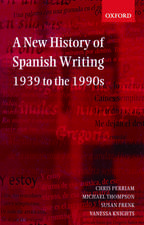Literature and Moral Theory
Autor Dr. Nora Hämäläinenen Limba Engleză Hardback – 18 noi 2015
| Toate formatele și edițiile | Preț | Express |
|---|---|---|
| Paperback (1) | 257.12 lei 6-8 săpt. | |
| Bloomsbury Publishing – 17 mai 2017 | 257.12 lei 6-8 săpt. | |
| Hardback (1) | 715.08 lei 6-8 săpt. | |
| Bloomsbury Publishing – 18 noi 2015 | 715.08 lei 6-8 săpt. |
Preț: 715.08 lei
Preț vechi: 1027.99 lei
-30% Nou
Puncte Express: 1073
Preț estimativ în valută:
136.83€ • 143.22$ • 113.89£
136.83€ • 143.22$ • 113.89£
Carte tipărită la comandă
Livrare economică 31 martie-14 aprilie
Preluare comenzi: 021 569.72.76
Specificații
ISBN-13: 9781501305368
ISBN-10: 1501305360
Pagini: 256
Dimensiuni: 152 x 229 x 16 mm
Greutate: 0.51 kg
Editura: Bloomsbury Publishing
Colecția Bloomsbury Academic
Locul publicării:New York, United States
ISBN-10: 1501305360
Pagini: 256
Dimensiuni: 152 x 229 x 16 mm
Greutate: 0.51 kg
Editura: Bloomsbury Publishing
Colecția Bloomsbury Academic
Locul publicării:New York, United States
Caracteristici
Gives a systematic overview of the shared concerns and central disagreements among moral philosophers (e.g. Martha Nussbaum, Iris Murdoch, Cora Diamond, Peter Winch) who have turned to literature for ethical illumination
Notă biografică
Nora Hämäläinen is post-doctoral researcher and temporary lecturer in philosophy at the University of Helsinki, Finland. She is the co-editor of Language, Ethics and Animal Life (2012) and former Editor-in-Chief of the Helsinki-based cultural weekly Ny Tid.
Cuprins
AcknowledgementsIntroductionChapter 1: A Literary Turn in a Neo-Aristotelian FrameworkChapter 2: Literature, Moral Particularism and Anti-TheoryChapter 3: Generality in LiteratureChapter 4: Between Literature and Theory: Nussbaum and MurdochChapter 5: Literature as Critique of Moral TheoryNotesReferences
Recenzii
Hämäläinen gives you a useful map of the territory and shows you how we got to where we are now.
Hämäläinen's study is a great achievement. The reader finds not only a map of what turns out to be a vibrant field of moral philosophy, but also a strong proposal regarding the question of how to proceed in the future.
This impressive book looks at how the study of the rich particularities of literary works became an important part of post-WW II, English-language moral philosophy. The result was to weaken the hold that totalizing, abstract theory was supposed to have on 'analytic' moral philosophy for most of the 20th century. Ha¨ma¨la¨inen (philosophy, Univ. of Helsinki, Finland) suggests a way to understand moral philosophy's relation to literature, a way that allows for a truce between those who seek to make literature an ally of theory and those who appeal to literature to supplant theory. The key, she argues, is to recognize that at this time, moral philosophical consensus is neither possible nor desirable. The author's knowledge of her subject is wide and deep, and her discussion of different figures and positions is perceptive and judicious. Summing Up: Recommended. Upper-division undergraduates through faculty.
This is a sympathetic but clear-eyed critical evaluation of recent explorations of the relevance of literature to moral philosophy. Its insightful mapping of the territory brings out important differences between the main participants, and suggests one way in which they might be reconciled without sacrificing their emancipatory effect on the future conduct of ethical reflection.
Some of the most fundamental challenges to analytic ethics have come from moral philosophers who believe literature holds forth the promise of transforming received views of what moral thought is like, and of the kinds of difficulties it presents. Hämäläinen's Literature and Moral Theory offers an insightful and encompassing tour of this 'turn to literature,' describing with particular grace and thoughtfulness the writings of Iris Murdoch and Martha Nussbaum, two of this movement's most significant figures.
Hämäläinen's study is a great achievement. The reader finds not only a map of what turns out to be a vibrant field of moral philosophy, but also a strong proposal regarding the question of how to proceed in the future.
This impressive book looks at how the study of the rich particularities of literary works became an important part of post-WW II, English-language moral philosophy. The result was to weaken the hold that totalizing, abstract theory was supposed to have on 'analytic' moral philosophy for most of the 20th century. Ha¨ma¨la¨inen (philosophy, Univ. of Helsinki, Finland) suggests a way to understand moral philosophy's relation to literature, a way that allows for a truce between those who seek to make literature an ally of theory and those who appeal to literature to supplant theory. The key, she argues, is to recognize that at this time, moral philosophical consensus is neither possible nor desirable. The author's knowledge of her subject is wide and deep, and her discussion of different figures and positions is perceptive and judicious. Summing Up: Recommended. Upper-division undergraduates through faculty.
This is a sympathetic but clear-eyed critical evaluation of recent explorations of the relevance of literature to moral philosophy. Its insightful mapping of the territory brings out important differences between the main participants, and suggests one way in which they might be reconciled without sacrificing their emancipatory effect on the future conduct of ethical reflection.
Some of the most fundamental challenges to analytic ethics have come from moral philosophers who believe literature holds forth the promise of transforming received views of what moral thought is like, and of the kinds of difficulties it presents. Hämäläinen's Literature and Moral Theory offers an insightful and encompassing tour of this 'turn to literature,' describing with particular grace and thoughtfulness the writings of Iris Murdoch and Martha Nussbaum, two of this movement's most significant figures.



























